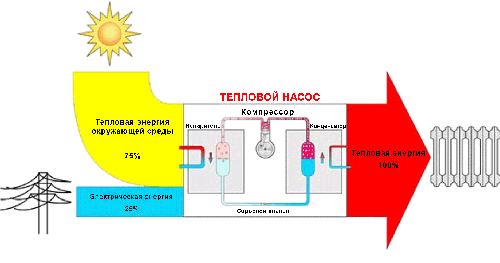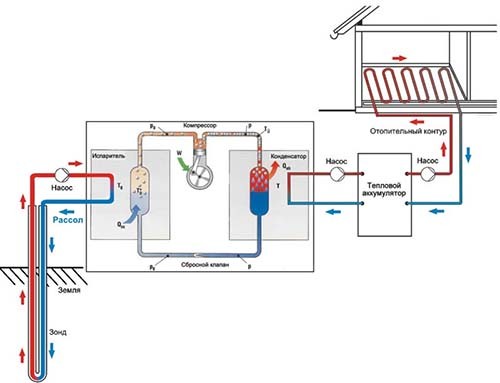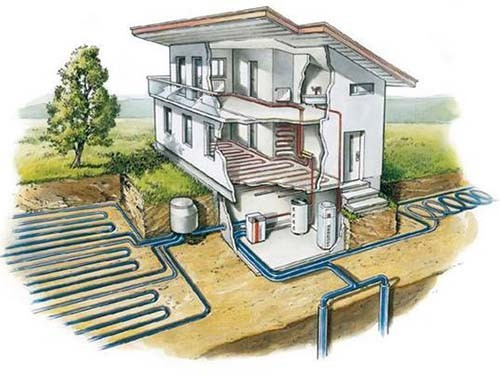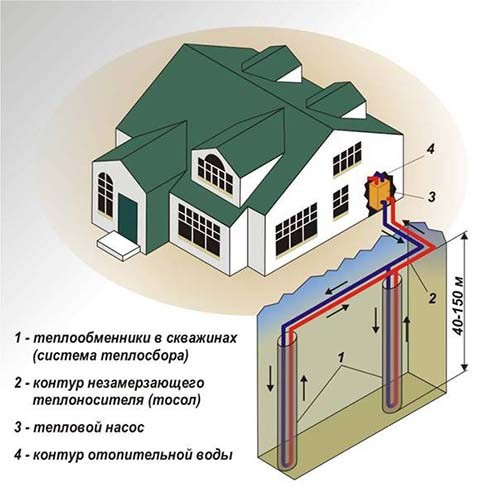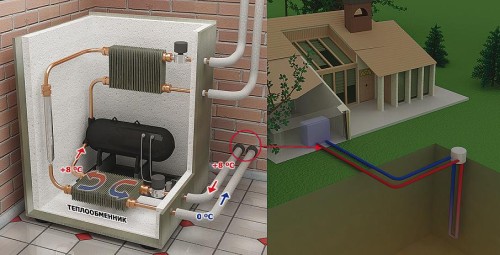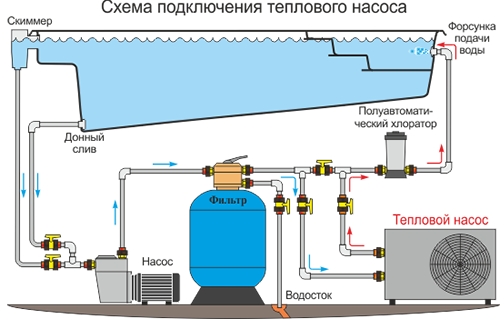
Scheme and installation of thermal pumps Climate

The cost of gas and liquid fuel is growing in geometric progression, so more and more owners of private houses are thinking about the use of alternative heating systems. One of the most promising proposals is the installation of heat pumps operating at the expense of natural coolants. With their help you can warm up a big house and significantly reduce heating costs. In this article we will talk about how to connect the heat pump.
Content
The capabilities of the heat pump
The modern market offers a large selection of heating systems and aggregates, and the option coming on cost and efficiency seem to be difficult. However, it turns out that the service of the apparatuses costs exorbitantly expensive - the price of fuel, the need to approve the installation of various instances, etc. The heat pump is a serious competitor to all heating systems, since it does not work on fuel (gas, electricity, firewood, coal), but on natural sources (water, air, sunlight, the power of the earth). The principle of operation is different - the heat pump does not produce heat, but only takes it from the source, accumulates and sends to the house.
The specificity of the heat pumps allows them to spend only 250 W electricity to produce 1 kW of energy. Thus, for heating a large house of 100 m², only 2.5 kW will be required. Compared with conventional boilers and heating devices, the difference is phenomenal, is not it?
Types of thermal pumps
There are several types of thermal pumps in the nature of the heat source used: earth, air and water. The earth-water system takes heat from the soil layer under the house using a special probe or manifold. The vehicle is the non-freezing fluid, which delivers heat from under the ground to the pumping unit, where it goes to the heating system of the house. The collectors at the same time must be placed on the depth below the soil freezing level. It is advisable to use them in large areas, and for small possessions, for example, probes are suitable for 4-6 acres.
The air-water heat pump heating system, as you can guess, accumulates heat from the air. For this use evaporators and fans. Water-water pumps take heat from water. They can be installed even if there are no natural sources nearby - deep installations can swing heat from groundwater. When water enters the pump, it is cooled and comes back through a special well.
Principle of operation
The heating pump system consists of several elements: heat source, pumping installation and aggregates, which are distributed and accumulated heat by low-temperature heating. In other words, the colder will be water in the pipeline, the better the installation will work.
In fact, the heat pump is working almost the same as an ordinary refrigerator, but if it takes heat from the inside and produces it through the grille in the back wall, the pump acts with precision on the contrary - takes heat from the external space inside. The heat source can be air, water or earth. The advantage of air systems is that the air is everywhere and always, and for water or earth pumps to the source, it is necessary to get to the source - to drill a well or dug the pit. At the same time, the soil and water are optimal thermal batteries with a relatively constant temperature throughout the year.
It is better to engage in the installation of the heat pump even at the construction stage of the house to immediately calculate the heating system, taking into account the subsequent installation of the unit. But if the house has already been commissioned, it can also be integrated into it, but it will cost it much more expensive. So does it make sense to spend money on re-equipment of the entire heating system or better leave everything as it is and choose something less expensive?
To equip a boiler room with heat pump you really have to spend a lot more than if you were putting a boiler, but all costs will quickly block with meager exploitation costs. The installation of the heat pump will pay off in 1.5-2 years. In this case, the power consumption will decline, you will not need to constantly monitor the operation of the system, and permits for the installation of such equipment are not required. Thermal pumps are completely safe to use, so they can be safely put in residential premises. They have a presentable appearance and compact enough. Which side does not look at, this is the most profitable and promising method of heating.
How to choose a heat pump
If you decide to install the heat pump, it remains for small - choose the appropriate option. It should be repeated from the energy state of your home. Regardless of the selected system, it is necessary to create high-quality heat insulation of walls, foundations and roofs so that the heat produced by the pump does not waste. The larger the house, the smallest the costs of its heating.
You also need to calculate the power of the pump depending on the degree of heat loss. If you have a home of the old building from brick or wood with wooden window frames and poor-quality insulation, then it will take about 75W / m² for heating. For modern houses with good insulation, the thermal need will be below - approximately 50 W / m². If you are as followed by the walls, gender and roof, then only 30 W / m² will be enough to heat.
Useful advice: As practice shows, the optimal version of the heating system in a residential building with heat pump is a warm water floor. Holding its power, be sure to consider the type of flooring - the tile warms down worse than the tree, the concrete screed is also warm enough. It is best to make a boardwalk or pour a special polymer tie.
If you are not indifferent to the environmental safety of your home, the heat pump in this regard is fully consistent with your interests. It does not throw any harmful connections into the atmosphere and does not use valuable natural resources. For him, it is not necessary to cut down the forest or dry the swamp - the system works on inexhaustible heat sources. It is completely safe and eliminates the likelihood of a fire or explosion during high-quality insulation of wires. These characteristics do not have a single heating installation in the world, and one can safely say that even if the heat pump is someday and there will be flaws, they will remain unnoticed against the background of its advantages.
Heat pump do it yourself
Many owners of private houses scares the cost of installing the heat pump. And even the fact of complete payback of costs for a short period does not convince them in the opposite. Therefore, a completely reasonable question is born: "Is it possible to make heat pumps for heating with their own hands?". We are in a hurry to give lovers to work with your hands for the benefit of savings - the heat pump can be collected from quite ordinary parts or used spare parts.
If you set a pumping heating system in the already built home, then make sure that the electrical wiring state and the availability of the counter are properly. The power of the measuring instrument must be at least 40 amps.
How to make a heat pump:
- To assemble the unit you will need to buy a compressor. The compressor is suitable from the air conditioner, which can be purchased separately in a specialized company for the sale of climate machinery or take used in the workshop.
- To fix the compressor, use the L-300 brackets.
- To make a condenser, take a 100-120 l stainless steel tank, cut it into two halves and install inside the coil.
- The coil can be made it from a copper tube of a small diameter (ordinary plumbing or from the old refrigerator). The tube should not be thin-walked, otherwise it can burst in the process. Make a serpent with a thickness of the wall at least 1 mm. Take an oxygen or gas canister and screw the tube on it, withsting an equal distance between the turns. Fix the tube in the desired position using an aluminum corner - take it so that each of the holes in the corner is opposite the turns.
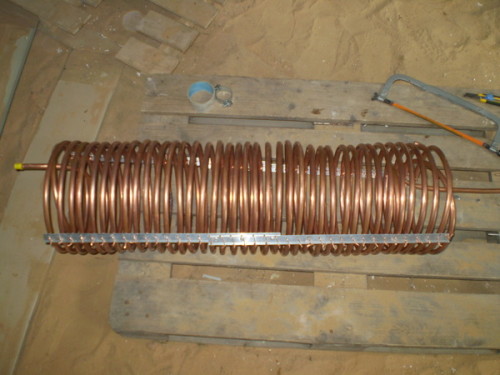
- After installing the coil weld two parts of the tank, the threaded connections are welding.
- As an evaporator, you can use any plastic container by 60-80 liters. It is necessary to mount the coil from a thin tube with a diameter of 19 mm. Attach the evaporator to the wall using the L-shaped bracket of the suitable caliber.
- For a pipeline that will deliver and output water from the pump, use conventional water pipes.
- At this stage you will need a specialist in refrigeration equipment, if you yourself are not. He will collect the whole system together, weld copper nozzles and pulls inside Freon. Do not even try to fulfill this work yourself, if you do not have experience with Freonon!
Connecting the heat pump
The technology of connecting the heat pump depends on its variety. So, for the air-water system, it is not necessary to install probes, and therefore the installation is carried out differently.
Features of the installation of thermal pumps:
- Air-water - set this pump easier and faster, because for this it is not necessary to carry out excavation or drilling work. As a rule, the geothermal installation is mounted near the residential building at a distance from 2 m to 20 m. The pump is best installed on a well-ventilated area to ensure full-fed fresh air access. It is also not allowed to locate a number of open sources or other heat. To protect the heat pump from precipitation and mechanical impacts, it is recommended to install a canopy above it, but so as not to create barriers to high-quality ventilation. The equipment installation site should be free and provide access to the technique on any side to make maintenance or repair if necessary. The pump should be installed on a metal frame-frame, in order to avoid additional noise and vibration during operation. The frame must be fixed on the ground, rubber gaskets between it and the pump.
- Earth-water - installation can be vertical or horizontal. In the first case, you will need to use a drilling unit to make a well depth of 50-100 m. The well diameter should be 20 cm. Then it is necessary to lower the geothermal probe and connect it to the system. For one pump, several wells may be required. Their quantity and depth are determined by the need for energy and geological characteristics of the area.
For the horizontal installation of the pump, you must roll out the trench near the house. The depth of the trench should be 1.5-2 m depending on the level of primerization of the soil. The pipe system is placed there, which connects the coolant with the pump through the base part of the house. - Water-water - To assemble a water collector, use conventional PND pipes filled with heat carrier, that is, with water. After the assembly, the design should be transferred to the reservoir, immerse in water and towed to the middle of the pond. It is extremely important when the pump is connected, do not exercise the heating system together with the heat generator, but to make the wiring separately. In the inner circuit, it is necessary to install an expansion tank to install the water level in it above 50 cm of the uppermost point of the heating circuit. So that the pump served longer, the pipeline to the power plant is better to connect flexible rubber hoses - they reduce vibration. To control the performance of the system, pride the installation of pressure gauges and temperature sensors in the fields of input and fluid output. It will also be necessary to install a drainage device at an extremely lowest point of heating for a complete drain of water from the system.
Will summarize the topic of profitability and the benefits of installing thermal pumps video below:
The heat pump device is quite simple, but its installation can cause difficulty masters. In order to avoid incorrect operation of the system, it is better to entrust its installation of professionals.




